Trail History (NSW)

Mt Kosciuszko is the highest land point in Australia at 2228m. After walking the entire distance to and from the Thredbo accommodation area I can say that I appreciate all of it's height.
Mt Kosciusko or Mt Kosciuszko underwent an approved name change some years ago after it was realised that the surveyor who named it (after the shape of a Russian tomb) mistakenly spelt it. (What is it with these surveyors Martin?) Some 'people in high places' (mind the pun) worked out at a later date that officially the Russian name has a 'z' in the spelling. Either will do really - I always have to think about the spelling and still get it wrong!
This bloke was really just looking for a good survey point and didn't realise that this was Australia's highest point. Therefore there's a nice trig monument at the top. Nice. The mountain had been transversed by humans before with the local aboriginal tribes having known about it and later white settlers using the high alpine plains for grazing their stock.
If you get the chair lift up you get to avoid the steepest part of the climb up the ski slopes. I saved myself 20 bucks and walked. Once at the plain level it's a comfortable stroll along a paved path for a short distance and then along a winding metal grating path. This is to minimise environmental damage to the fragile alpine ecosystem and to make the journey quite a bit faster. It took me 2h 20min to walk up the entire distance and about a half hour less coming down. On fine days don't think you'll be there absorbing the tranquillity and achievement of your summit ascension alone - there was a fairly steady stream of traffic when I was up at the top. A bus load of kids were on their way up when I was about a km down. Oh - it's 12km round trip from the top of the chair lift to the summit... that is until you get half way and it says it's 6.5 to the top. You do the math. If you add in the ski slope walk it's about 16.5km in total. A good workout, but fantastic views and scenery on the way up, at the top and going back down. Each direction you look provides a vastly different view which was fantastic and much appreciated. My favourite was to the NW towards Khancoban over Byatt Camp. Choose your own when you get there.
Check out the sky, terrain and beauty in the picture below of Lake Cootapatamba just to the SE of the summit. It was like a totally different world up there. A bearable 10 degrees (not taking into account wind chill) while I was there. Plenty of people to take your photo for you, but watch your batteries go dead with the temperature.
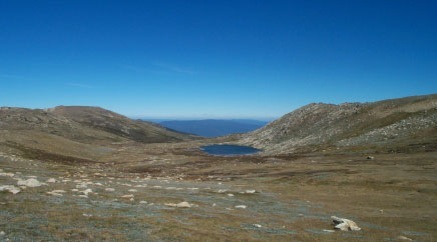
I rolled into Khancoban two days after climbing Mt Kosciuszko with my quads still a little stiff and sore. Beside the town is the Khancoban Pondage which is basically a part of the Murray Hydro-electric Scheme. Khancoban is another town I'd like to retire to if it was in Queensland. Obviously someone had a bit of talent in planting trees here as it's just a really nice place to ride into and around. Only about 400 people live here (down from a 7 000 peak) but they're as friendly as could be. Just enough facilities for a needy traveller and icy cold beers at the hotel. They'd seen a few of my type before. Comforting, but you could see that sort of question in their eyes.
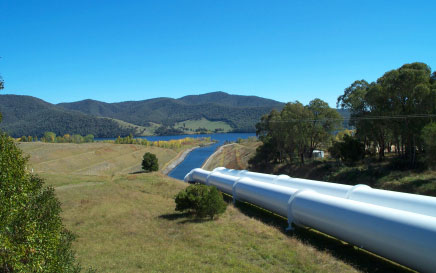
Photo : Murray 2 Power Station Pipes just outside Khancoban.
They hum. Another cyclist's sky.
Adaminaby is a trout town. People go there to get trout. Real big trout. At the mouth of the Eucumbene River a bloke had caught a 5.5kg trout fly fishing a week before I arrived. Lake Eucumbene of course provides the expanse of water for trout to grow this big. From the reports I read and heard you almost can't not catch a trout if you throw a line in. (My line of course happened to be amongst the scrub on the other side of the Eucumbene River somewhere.)
None of this trout farm business. When the wild trout are caught apparently it's good tucker - a better taste and a healthier pinkish colour. I had long thin trout for dinner while I was in Adaminaby (sausages) so missed out on the real thing. Lars the caravan park owner gets a few given to him each week by his guests - which he all too happily accepts.
All this at about 1000m elevation, so if you can't fish very well in the colder months strap on a pair of skis and go hit the snow. A bakery is in town to warm your heart and the Snowy Goose has an bar long enough to accommodate the most lengthy trout stories and tales. If you can't ski and can't fish then just head around the district taking photos. There's a variety of landscapes and subjects far too willing to pose for you with their day's takings.
Gibraltar Falls was a good 8km climb on the bike, but it was well worth the effort. Although smaller than Steavenson falls in Victoria it offered more variety in a waterfall. The falls are located to the south west of Canberra not far from Tidbinbilla, on the way to Corin.
From above, the creek looked almost insignificant - the type you don't even bother removing your cycling shoes for when fording because you can take a big step over it. But once over the edge the water took a whole different personality. Different paths were taken by the water to get to the pool some 8-10m below. Some paths were major, others were minor, some dribbled, a few gushed, one snaked and whipped around a corner to pour upon another while others stopped and started in spurts of a few seconds. More was happening so go visit and see the rest. The photo below doesn't really show all of this. Unfortunately about a third of the falls to the right is missing in the photograph.
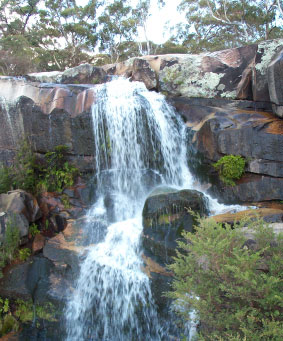
I felt for the dry granite boulders on the eastern face of the falls which were missing the caressing fluids, while I was amused at the attempts of some plants to stay well hydrated and out grow other plants in the locality on the barest of rock surfaces.
Tidbinbilla isn't just a way cool name for a place to live. It's got a way cool place to visit called the Deep Space Tracking Centre. Besides massive radio telescopes everywhere outside pointing at the sky and an assortment of gadgets lying about which receive or send important data, there is a plethora of information about space everywhere.
Inside the centre you can read all sorts of stuff, watch a video documentary on Robert Goddard and on the Tidbinbilla facility and poke around all the display items that they have. My favourite bits were the chunk of moon rock, the NASA program patches that the astronauts designed, the space food and the video on Dr Goddard. I was engrossed for about 2 hours. Then I ate a very tasty lunch after I read my weight on the gravity conversion scales.

When you read up on the articles about how Australia has played such an important role in events such at the moon landing in 1969 and the exploration of Mars, it makes you feel mighty important and proud. A lot of information that really should be made prominently public. Go watch 'The Dish' again.
The town of Gundaroo is very unique. It rates a mention in a Banjo Paterson poem, it has a wine bar but no regular sort of pub (that I could find anyhow), it is focused on the tourist and not the traveller and it seems to be more advanced in street sign design than the place called Canberra just down the road. The people are friendly and more than helpful and appreciate country living.
My trip was highlighted by the visit to Wayne the bike frame maker. A trendy sort of a village as a whole and well worth a visit for a couple of hours.
Crookwell is a town from way back. As I was riding into Crookwell I noted the road to Goulburn milestones which indicates a very age weary road. Many of the buildings around the Crookwell area date to the mid to late 1800s. Stone buildings in a convict style are aplenty.

It's just 3 hours from Sydney and half that from Canberra and is at about 915m elevation. 'Kiamma' was the original name for the town which means, in Aboriginal, ' good fishing ground'. Trout were first released on the Australian mainland here in the Wollondilly river in 1888, so they've had plenty of time to grow.
Just to the east at Taralga is where McArthur started breeding Merinos to jump start the wool industry at a place called Richlands. A few other settlements in the 'Crookwell Region' offer gold panning, fishing, art and craft and an variety of unique sheep and wool related business and history.
The wind which is notable when you are riding a bike in this area does not go to waste - Crookwell has Australia's first fully commercial grid connected wind farm. You can check this farm out, which operates in a complimentary way with the sheep farming in the area, from a viewing area 15km out of town towards Goulburn.
Today Crookwell has a handful of pubs, a sock factory, a potter, a choice of pubs and accommodation, and all the modern facilities which enable towns its size to continue to be prosperous.
The Wombeyan Caves are just tops. There are about 6 caves in total, with one being a cheaper self guided cave which you wander through at your own pace. The others require a tour guide and cost about $10 per cave - a 'must do' your visit as the information they share is worth every cent.
The formations within these caves are lit by electric lighting and were one of if not the first in the Southern Hemisphere to have this technology. Some of the structures formed in the limestone are unique in Australia and, in some cases, unique on this planet. Breathtaking caverns and unusual crawl-ways (which you now walk through!) Provide diversity in your limestone looking experience. And yes, when the guide turns off all lights - it is very dark.
These caves have been toured through since the days of corsets and top hats... crawling through dressed to the tee with miners candle holders and a guide holding burning magnesium. They were keen and a little poorly dressed for the occasion in those days, plus it cost them each about a weeks salary.
Wombeyan marble is cut from the nearby quarry into 22 tonne blocks and sent to Sydney where it is made into tiles for the 'well-to-dos' kitchens and floors and for other grand pieces of furniture, decor and art. The altar cut from the local marble in the picture below is from the Taralga Catholic Church 35km to the south west.
Contact the caves on (02) 48 43 5976.
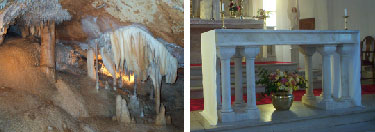
Oberon's weekly Visitor Centre sheet states "Find yourself in Oberon". Well I did (physically anyway) and was pleasantly surprised by the facilities and list of events and things to do. Steve and I agreed that Oberon had a 'New Zealand' feel to it. We couldn't work out exactly why, but it did. This town is 1113m above the Pacific Ocean, has a town population of about 2 600, gets the occasional snowfall and experiences definite seasons. All your mod cons are available in terms of facilities, and more often than not you get a choice, which keeps the markets competitive. Go to the cafe in the main street called 'Rumours of Oberon'. (A great place to hang out, and I want to know how they fit a band in there and still serve hot chocolate with marshmallows.)
It seems Oberon (King of the Fairies, A Midsummer Night's Dream) is a quadraped mecca. Rodeos, polocrosse, agricultural shows, horse trials, horse endurance rides and an active equestrian club suggest so anyway. As well there are Great Ass Treks - donkey/ass tours through the area and beyond. John (the Donkeyman) who operates the ass treks is co-ordinator of the BNT, so while in town on your BNT trek contact him.
Oberon also has a motorcycle club for a mode of transport which generates wind in your hair, the Jenolan Caves a short drive away, Kanungra Boyd N.P. not much further away, a Needleworkers Group, Spinners and Weavers Guild, and a variety of festivals and exhibitions throughout the year.
For those so motivated my little spiel here to move to Oberon, you'll find the local industries are prime lambs, beef cattle, brussel sprouts, broccoli, potatoes, peas, nut plantations, tree nurseries, bulb farms and timber processing, and of course tourism. Take your pick if you're multi-skilled.
If you're into cold dark and dingy places then The Jenolan Caves may be just the place for you to spend some time. If you like geology or just staring at amazing underground limestone formations this could also be the place for you.
The Jenolan Caves Reserve was declared in 1866, but was first visited by... visitors (!) in 1838 making it Australia's first tourist attraction. How interesting when you consider how they explored caves in those days. The cost is similar to that of the Wombeyan Caves but the setup is much more advanced and commercial. For a comparative feel I'd say Wombeyan was 'Oz' and Jenolan was 'Sydney'.
The limestone is almost entirely CaCO3. That's a scientist's way of saying 'calcite'. There are a number of caves to be led on a tour by. The Lucas, Chiefley, Orient, River, Imperial, Diamond, Jubilee and Pool of Cerberus caves to name nearly all of them. Each offer a different experience, but if you're after a really different experience then get yourself on a theme tour (educational, history, geology, drama, mystery, ghost) or do some adventure caving (crawl around with a guide and get grubby and look like a miner in generally difficult parts of the caves). For these of course you need to book in advance and have a group and more cash. Contact the caves on (02) 63 59 3311.
(While we're talking caves there's also the Abercrombie Caves to the west a little. Contact them about their caves on (02) 63 68 8603 and visit Crookwell while you're in the area.)
Some people I know think I am impartial to art galleries and crafty stuff. I don't mind the odd squizz though, and this I did at the Art Gallery of NSW. I had been to Sydney twice before but on those visits did the major attractions of which there is really no need to mention ...but will for our international guests who didn't watch any 2000 Olympic coverage (Opera House, Harbour Bridge, Stadium Australia, Centre Point, The Rocks, ferry rides, the Olympic Games... most of the stuff in the photo below). So, I was on this encounter with our most famous city, able to check out the so called 'secondary' attractions.

Anyway, back to the gallery... I was far more impressed with the selection and variety of art presented her than in the Canberra Gallery. There were some fascinating sculpture type works and about six two dimensional pieces which I wouldn't mind having in my personal collection. My eye for the unusual means most of you wouldn't share the liking for these particular ones, but I feel there was something for everyone in the collections presented here. Very diverse.
The gallery had an exhibition on of the entries an/or winners of the annual art competition... which I can't remember the name of! Oh dear. What a shame/how pathetic of me. It's the one in which unusual portraits / caricitures are the focus... you know the one! I didn't go in as I had neither the time or money but would have liked to. Hang on... it's listed on the leaflet in my hand! The Archibald, Wynne, Sulman and Dobell Prizes!
The permanent galleries contain 15-18th C. European art, 19th and 20th C. Australian art, contemporary art, Asian art, Aboriginal art, a theatre, library, and study area. There are places to eat, and they have toilets that flush. A parenting room for those with parents, public telephones that work, disabled access and helpful and cheery information people and guides.
Lithgow was where I got off the train from Sydney. Home of The Lithgow Flash' aka Majorie Jackson (great name, Olympic legend) who is not mentioned on their tourist leaflet but has a bronze statue in the main street. Work that out. Also the location for questionable panther sightings which I thought should be closer to Penrith.
Lithgow's a hub for visiting many of the attractions in the district : Wollemi N.P., several lakes and fishing areas, Aboriginal sites, stunning mountain scenery, Newnes with the glow worm tunnel, power stations, the ZigZag Railway, and various museums and historic houses.
I thought Lithgow deserved an entry here as it's just off the BNT and I didn't have time to stop and look around for too long. It had a 'homey' feel to it and the people were nice.
The Upper Hunter Region in NSW is well known amongst horse and wine lovers. This place is also loved by people who dig up coal and like to fish. I spent a few days in the region and was suitably impressed with the attractions, the people and the climate and the attitude that seemed to envelope the area.
Thousands of acres of grapes are grown here to fuel the evenings of many Australian parties and social gatherings. I sampled a few of the local products and I have to agree that Australian wine is the best on the planet. Each of the wineries has a cellar on site and production is carried out locally. The big names and the smaller names are nestled here and they're all worth a go. Get yourself a mini bus and some mates and go on a road trip, but bring the Berocca, sunnies and icepack.
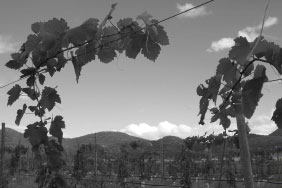
There are innumerous studs in the Upper Hunter. Not the type you find on Levis or hanging out at the local pubs, but the type with manicured paddocks, painted wooden fences and smelling of horse dung. A lady in Scone told me there were 83 studs around Scone... and that's only a small section of the region. Widden Stud was the one of note that I passed through and it was a 'full on' operation. Horse folk I know tell me that this is sacred ground in the Australian horse breeding industry. I won't argue as I know little of horses. Some big name horses have chewed a cud in this area and big name folk come here to scout for the next generation of prize winning gee gees.
If you want to experience a town that has it's finger on the 'how to sell yourself to the traveller' pulse , then Nundle's the place to visit. From the moment I rode into town I got the impression that there was plenty to see and do even though the town itself is quite small. They tell you what they have and it's not hard to find. I know a heap of towns that could learn a very valuable lesson from what has been done here.
Nundle's 60km to the south east of Tamworth (country music capital of Australia) nestled amongst some ranges. Check out these things in the local area : nursery, yabbie farm, Dag Sheep Station, Hanging Rock (yes, another one), Sheba dams, trout farm, fossicking areas, Ponderosa Park, Sandy Hills Lavender Estate and Chaffey Dam. In town you can visit the Old Church Boutique, Woollen Mill, Mt Misery Mine, Colonial Cottage, Court House Museum, Lantern Gallery, Golden Opportunity Store, bowling club, golf course, Craft Co-op, or take a stroll on the Nundle Village Heritage Walk.
The locals were more than helpful and knew what was going on in town. They were all too interested and willing to help the cycling traveller as well. I would have stayed here for the night but had to keep moving (pushing as it turned out).
Believe it or not, the Tenterfield Saddlery is not the only place of note in Tenterfield. And Peter Allen is not the only 'son' of note in this town.
Places : Stannum (meaning 'tin' but not made of this) House (1888), the Saddler's Shop, School of Arts, Railway Station Museum (1886), Court House (1885), Police Station (1874), Cobb and Co, Major Thomas' grave, Ghost Gully Erosion formation, Old Cork Tree, gateway to Girraween N.P.(QLD), Bald Rock N.P., Boonoo Boonoo Falls and N.P., Sundown N.P., Glenlyon Dam, local wineries, WW2 tank traps, Thunderbolt's Hideout (bushranger), Drake fossicking area... and the list goes on.
People : Sir Henry Parkes made his 1889 Federation Oration in the School of Arts; Major J.F.Thomas practised and lived here, and owned the newspaper after he'd defended Breaker Morant in South Africa in 1902; the son the foreman who built the post office who stood on his head on top of the tower when it was completed; Peter Allen a notable entertainer; S.A.Donaldson first premier of NSW and participant in the last recorded duel in Australia owned Tenterfield Station; Sir H.Chauvel was the first to command a military corp.
For interest, the first Campdraft held in Australia was in Tenterfield and the first air mail service in Australia included Tenterfield, Lismore and Casino. There's more history here than you can poke a stick at it seems. (Think about that.)
Tenterfield was named (some debate) by S.A.Donaldson. 'Tenters' are hooks which were set in the field to dry flax which was later used to weave cloth in the 'fields' in the Mill District. Tenterfield was on the shortlist to be the nation's capital. Unfortunately it was beaten by Canberra for this honour. (I would have liked Parliament House, the War Memorial, National Museum and Tidbinbilla to have been this close to Brisbane.) Population of about 3 300 humans and a variety of festivals are held for them and others to attend. Population of sheep and cattle and insect species unknown.
Some of the information included here was obtained from local people, local publications, notice boards and newspapers.
Trail History (NSW)
2/14/09
A little bit of history on some of the places visited in New South Wales.
Some of the names may be familiar. For those you don’t recognise, see the Towns Route page for a Google map.
